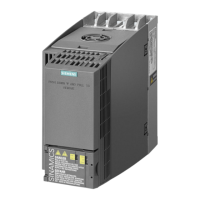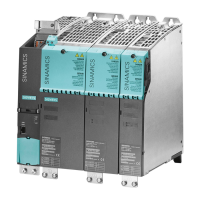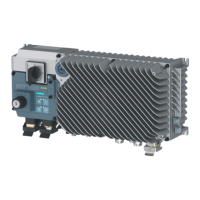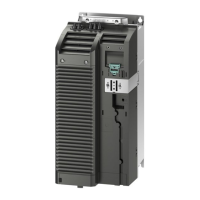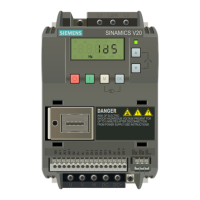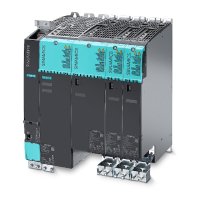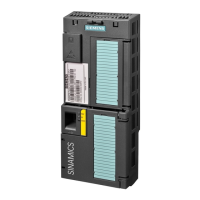Fundamental Principles and System Description
Engineering Information
SINAMICS Engineering Manual – November 2015
Ó Siemens AG
145/528
1.9.4.1.2 Insulated bearing at the non-drive end (NDE) of the motor
Apart from an EMC-compliant installation which essentially prevents rotor ground current, the use of a motor with an
insulated bearing at the non-drive end (NDE) is the second most important measure for reducing bearing currents.
Essentially, the insulated NDE bearing reduces the capacitive circular current in the motor by significantly increasing
the impedance in the circuit comprising the shaft – NDE bearing – motor housing – DE bearing – shaft. Since the
circular current increases in proportion to the motor shaft height, it is particularly important to install an insulated NDE
bearing on large motors.
Insulated bearings at the non-drive end are available for SIMOTICS SD series 1LG standard motors of shaft height
225 and larger as an option (order code L27) and this option is strongly recommended if these motors are to be fed
by converters. All SIMOTICS TN series N-compact trans-standard motors of types 1LA8, 1PQ8 and 1LL8 which are
designed for converter-fed operation ("P" in the 9th position of the order number, e.g. 1LA8315-2PM80) are equipped
as standard with insulated non-drive end bearings.
SIMOTICS M compact asynchronous motors series 1PL6, 1PH7 and 1PH8 in frame size 180 and larger are
optionally available with insulated non-drive end bearings (order code L27). These compact asynchronous motors are
equipped as standard with insulated non-drive end bearings in frame size 225 and larger.
In systems with speed encoders, it must be ensured that the encoder is not installed in such a way that it bridges the
bearing insulation, i.e. the encoder mounting must be insulated or an encoder with insulated bearings must be used.
1.9.4.1.3 Other measures
Motor reactors or motor filters at the converter output
EMC-compliant installation and the use of a motor with insulated NDE bearing are adequate measures in virtually all
applications for the purpose of maintaining bearing currents at a non-critical level, even under worst-case conditions
when stochastic disruptive discharges attributable to the EDM effect occur in the bearing.
Only in exceptional cases it might be necessary to take additional measures to further reduce bearing currents.
This can be achieved with common mode filters consisting of toroidal cores made of highly permeable magnetic
material. They are mounted at the converter output and enclose all three phases of the motor cable. These filters
present a high resistance to the high-frequency currents (EDM current and rotor shaft current) flowing to ground and
reduce them accordingly.
As common mode filters are not generally needed on SINAMICS drives, they are not offered as a standard option.
They are available only on request.
As a general rule, all measures implemented at the converter output which serve to reduce the voltage rate-of-rise
dv/dt have a positive impact on bearing current levels in the motor.
Motor reactors reduce the voltage rate-of-rise on the motor as a function of the motor cable length. Although they
help basically to reduce bearing currents, they cannot be regarded as a substitute to EMC-compliant installation and
the use of motors with insulated NDE bearings.
The capability of dv/dt filters plus VPL, dv/dt filters compact plus VPL and sine-wave filters to reduce the voltage
rates-or-rise on the motor is generally not affected by the motor cable length and achieves dv/dt values lower than
those obtained with motor reactors. The values attained with sine-wave filters in particular are markedly lower.
In consequence, it is possible to dispense with insulated motor bearings when dv/dt filters, or more particularly, sine-
wave filters are installed at the output of SINAMICS converters.
Grounding of the motor shaft with a grounding brush
A shaft-grounding brush can also reduce the bearing currents because the brush shorts the bearing. Grounding
brushes are optionally available (order code M44) for SIMOTICS SD series 1LG6 converter-fed motors of shaft
heights 280 and higher.
However, there are problems associated with shaft-grounding brushes. They are very difficult to construct for smaller
motors, they are sensitive to contamination and also require a great deal of maintenance. As a result, shaft-grounding
brushes are not generally a recommended solution for low-voltage motors in the low to medium power range.
IT system
In operation on an IT system, the transformer neutral is not electrically connected to ground as it is with TN systems.
The ground connection is purely capacitive in nature, causing the impedance to increase in the circuit in which high-
frequency, common mode currents are flowing. The result is a reduction in the common mode currents and thus also
in the bearing currents. With respect to bearing currents, therefore, non-grounded IT systems are more beneficial
than grounded TN systems.

